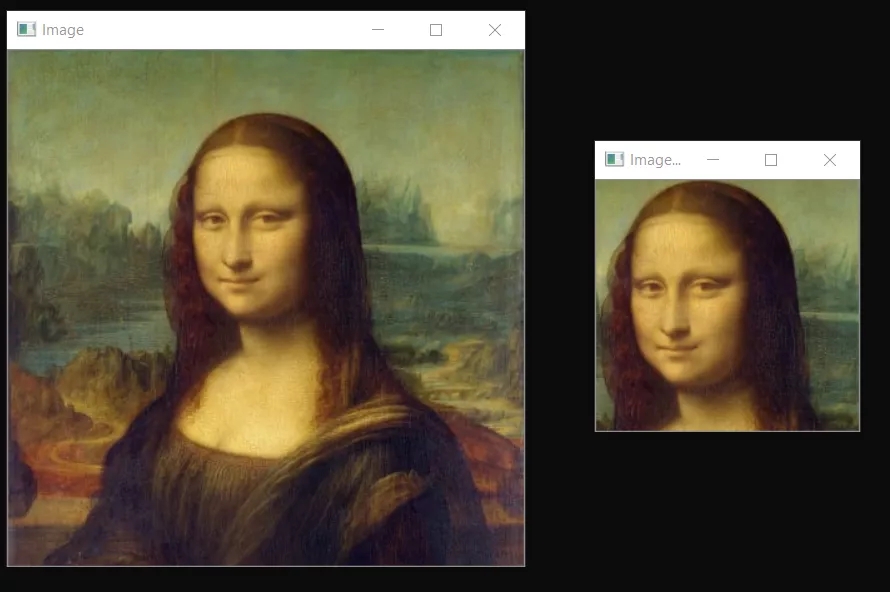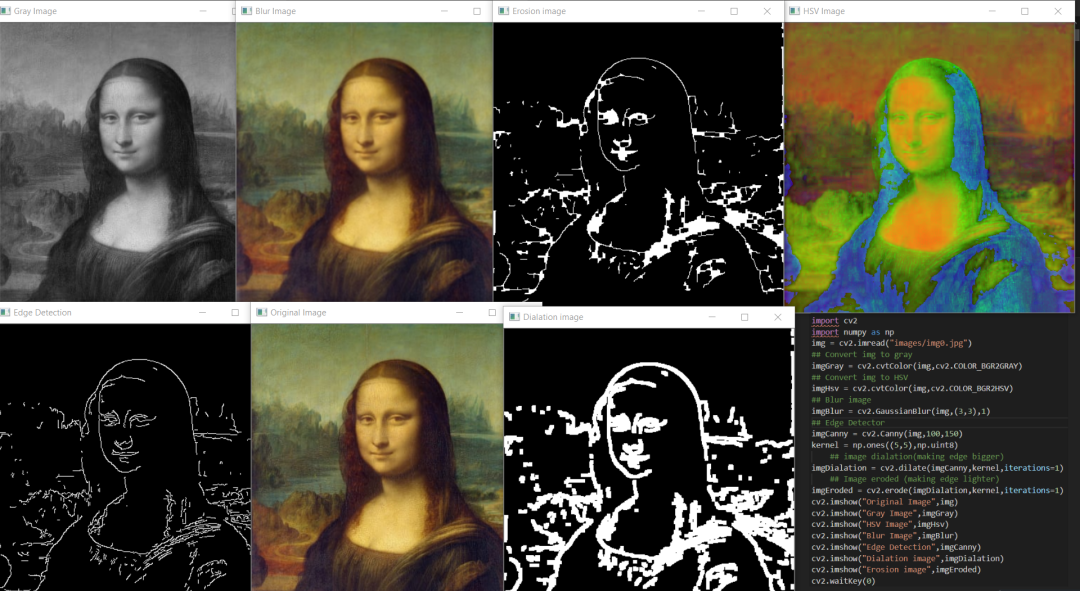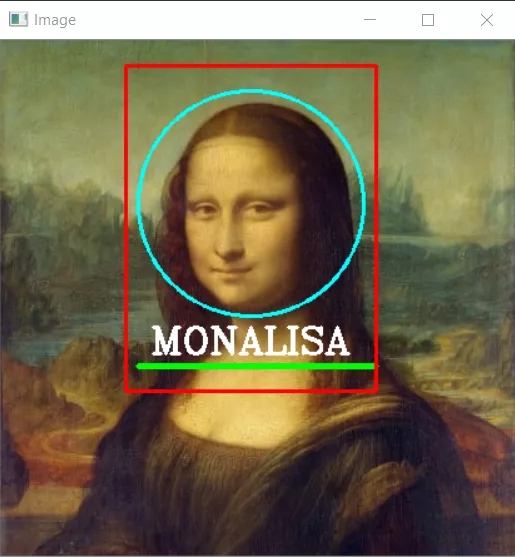opencv
opencv是計算機視覺中最受歡迎的庫,最初由intel使用c和c ++進行開發的,現在也可以在python中使用。該庫是一個跨平臺的開源庫,是免費使用的。opencv庫是一個高度優化的庫,主要關注實時應用程序。
opencv庫是2500多種優化算法的組合,可用于檢測和識別不同的人臉,實時識別圖像中的對象,使用視頻和網絡攝像頭對不同的人類動作進行分類,跟蹤攝像機的運動,跟蹤運動對象(例如汽車,人等),實時計數對象,縫合圖像來產生高分辨率圖像,從圖像數據庫中查找相似的圖像,從使用閃光燈拍攝的圖像中消除紅眼并提高圖像質量,跟蹤眼睛的運動,跟蹤臉部等。
它擁有大約4.7萬活躍用戶社區,下載量超過1800萬。谷歌,亞馬遜,特斯拉,微軟,本田等許多大公司都使用open cv來改善他們的產品,它更是驅動了ai的發展。
先決條件
在開始編寫代碼之前,我們需要在設備上安裝opencv。
如果你是proin編程專家,并且熟悉每個ide,那么請使用pycharm并從設置中的程序包管理器安裝opencv-python。
如果你是初學者或中級程序員,或者只是想關注博客,那么我們將使用代碼編輯器而不是ide。
只需轉到visual studio code網站并根據你的操作系統下載最新版本即可。
- https://code.visualstudio.com/download
現在,我們將創建一個虛擬環境,并在其中安裝opencv。打開終端,然后使用cd定位到桌面,使用mkdir 創建一個名為opencv
的文件夾,然后運行以下命令。
|
1
|
python -m venv env |
現在,使用env\scripts\activate激活環境,你會在c:\users\username\desktop\opencv之前看到小括號(env)出現。
現在,只需使用pip安裝opencv。
我們會在本文中涵蓋7個主題
1. 讀,寫和顯示圖像
2. 讀取視頻并與網絡攝像頭集成
3. 調整大小和裁剪圖像
4. 基本的圖像過濾器使用的函數
5. 繪制不同的形狀
6. 在圖像上書寫文字
7. 檢測并裁剪臉部
讀,寫和顯示圖像
要使用opencv讀取圖像,我們有imread()函數; 要顯示圖像,有imshow()函數,而對于書寫,我們有imwrite()函數。讓我們看看它們的語法。
imread():
|
1
2
3
|
img = cv2.imread("path_to_image.jpg/png")exampleimg = imread("images/dog0.jpg") |
imshow():
|
1
2
3
|
cv2.imshow("window name",img_var)exampleimshow("dog image",img) |
imwrite():
|
1
2
3
4
5
|
cv2.imwrite(filename, image)filename: a string representing the file name. the filename must include image format like .jpg, .png, etc.image: it is the image that is to be saved.examplecv2.imwrite('images/img',img) |
讀取視頻并與網絡攝像頭集成
讀取視頻文件與在opencv中讀取圖像文件非常相似,區別在于我們使用了cv2.videocapture。
句法
|
1
2
3
|
video = cv2.videocapture("filepath.mp4")examplevideo = cv2.videocapture("video/dog/dog.mp4") |
視頻是許多幀結合在一起的集合,每幀都是一幅圖像。要使用opencv觀看視頻,我們只需要使用while循環顯示視頻的每一幀。
|
1
2
3
4
5
|
while true: success , img = cap.read() cv2.imshow("video",img) if cv2.waitkey(1) & 0xff==ord('q'):##key 'q' will break the loop break |
要與網絡攝像頭集成,我們需要傳遞網絡攝像頭的端口值而不是視頻路徑。如果你使用的是筆記本電腦,但沒有連接任何外部網絡攝像頭,則只需傳遞參數0;如果你有外部網絡攝像頭,則傳遞參數1。
|
1
2
3
4
5
6
7
8
9
|
cap = cv2.videocapture(0)cap.set(3,640) ## frame widthcap.set(4,480) ## frame heightcap.set(10,100) ## brightnesswhile true: success, img = cap.read() cv2.imshow("video",img) if cv2.waitkey(1) & 0xff == ord('q'): break |
調整大小和裁剪圖像
調整大小是更改圖像形狀的過程。在opencv中,我們可以使用resize函數調整圖像形狀的大小。
句法
|
1
2
3
4
5
6
|
cv2.resize(img,(width,height))img: image which we want to resizewidth: new width of the resize imageheight: new height of the resize imageexamplecv2.resize(img,(224,224)) |
要首先調整圖像的大小,我們需要知道圖像的形狀。我們可以使用shape來找到任何圖像的形狀,然后根據圖像形狀,可以增加或減小圖像的大小。讓我們看看示例。
|
1
2
3
4
5
6
7
8
9
10
|
import cv2img = cv2.imread("images/img0.jpg") ##choose any imageprint(img.shape)imgresize = cv2.resize(img,(224,224)) ##decrease sizeimgresize2 = cv2.resize(img,(1024,1024)) ##increase sizecv2.imshow("image",img)cv2.imshow("image resize",imgresize)cv2.imshow("image increase size",imgresize2)print(imgresize.shape)cv2.waitkey(0) |
如果你不想對寬度和高度進行硬編碼,也可以使用形狀,然后使用索引來增加寬度和高度。
|
1
2
3
4
5
6
7
8
9
10
11
|
import cv2img = cv2.imread("images/img0.jpg") ##choose any imageprint(img.shape)shape = img.shapeimgresize = cv2.resize(img,(shape[0]//2,shape[1]//2))##decrease sizeimgresize2 = cv2.resize(img,(shape[0]*2,shape[1]*2)) ##increase sizecv2.imshow("image",img)cv2.imshow("image resize",imgresize)cv2.imshow("image increase size",imgresize2)print(imgresize.shape)cv2.waitkey(0) |

裁剪圖像
裁剪是獲取圖像的一部分過程。在opencv中,我們可以通過定義裁剪后的矩形坐標來執行裁剪。
句法
|
1
2
3
4
5
|
imgcropped = img[y1:y2, x1:x2](x1,y1): top-left vertex(x2,y2): bottom-right vertexexampleimgcropped = img[0:100,200:200] |
使用裁剪方法,讓我們嘗試從圖像中獲取蒙娜麗莎的臉。
|
1
2
3
4
5
6
|
import cv2img = cv2.imread("images/img0.jpg")imgcropped = img[50:250,120:330]cv2.imshow("image cropped",imgcropped)cv2.imshow("image",img)cv2.waitkey(0) |

你也可以使用paint來找到(x1,y1),(x2,y2)的正確坐標。
右鍵單擊圖像并保存,嘗試從圖像中獲取王卡。

提示:使用paint來找到正確的坐標,最后使用調整大小來增加裁剪圖像的大小。
“在尋求解決方案之前,請嘗試自己動手做。”
解決方案- https://gist.github.com/abhayparashar31/9b01473431de765c0a73e81271233d91
基本的圖像過濾器使用的函數
我們可以在圖像上使用許多基本的濾鏡操作,例如將圖像轉換為灰度圖像,模糊圖像等等。讓我們一一看一下比較重要的操作。
將圖像轉為灰度圖像
要將圖像轉換為灰度,我們可以使用一個函數cvtcolor,這里我們將cv2.color_bgr2gray作為參數傳遞。
|
1
2
3
4
5
|
imggray = cv2.cvtcolor(img,cv2.code)img: original imagecode: conversion code for gray(color_bgr2gray)exampleimggray = cv2.cvtcolor(img,cv2.color_bgr2gray) |
將圖像轉為hsv
要將圖像轉換為hsv,我們可以使用函數cvtcolor,這里我們將cv2.color_bgr2hsv作為參數傳遞。它主要用于對象跟蹤。
|
1
2
3
4
5
|
imggray = cv2.cvtcolor(img,cv2.code)img: original imagecode: conversion code for gray(color_bgr2hsv)exampleimghsv = cv2.cvtcolor(img,cv2.color_bgr2hsv) |
圖像模糊
模糊用于去除圖像中的多余噪聲,也稱為平滑,這是對圖像應用低通濾波器的過程。要在opencv中使用模糊,我們有一個函數gaussianblur。
|
1
2
3
4
5
6
|
imgblur = cv2.gaussianblur(img,(sigmax,sigmay),kernalsize)kernalsize − a size object representing the size of the kernel.sigmax − a variable representing the gaussian kernel standard deviation in x direction.sigmay - same as sigmaxexmapleimgblur = cv2.gaussianblur(img,(3,3),0) |
邊緣檢測
在opencv中,我們使用canny邊緣檢測器來檢測圖像中的邊緣,也有不同的邊緣檢測器,但最著名的是canny邊緣檢測器。canny邊緣檢測器是一種邊緣檢測算子,它使用多階段算法來檢測圖像中的大范圍邊緣,它由john f. canny在1986年開發。
|
1
2
3
4
|
imgcanny = cv2.canny(img,threshold1,threshold2)threshold1,threshold2:different values of threshold different for every imagesexampleimgcanny = cv2.canny(img,100,150) |
膨脹
膨脹是用來增加圖像中邊緣的大小。首先,我們定義一個大小為奇數(5,5)的核矩陣,然后利用核函數對圖像進行放大。我們對canny邊緣檢測器的輸出圖像進行了放大處理。
|
1
2
|
kernel = np.ones((5,5),np.uint8) ## defining kernel of 5x5imgdialation = cv2.dilate(imgcanny,kernel,iterations=1) ##dialation |
腐蝕
腐蝕是擴張的反面,它用于減小圖像邊緣的尺寸。首先,我們定義一個奇數(5,5)的核矩陣大小,然后使用核對圖像執行腐蝕。我們對canny邊緣檢測器的輸出圖像施加腐蝕。
|
1
2
|
kernel = np.ones((5,5),np.uint8) ## defining kernel of 5x5imgdialation = cv2.erode(imgcanny,kernel,iterations=1) ##erosion |
現在,在同一程序中將所有基礎函數應用于monalisa映像。

繪制不同的形狀
我們可以使用opencv來繪制矩形,圓形,直線等不同的形狀。
矩形:
要在圖像上繪制矩形,我們使用矩形函數。在函數中,我們傳遞寬度,高度,x,y,rgb中的顏色,厚度作為參數。
|
1
2
3
4
5
6
7
8
9
|
cv2.rectangle(img,(w,h),(x,y),(r,g,b),thickness)w: widthh: heightx: distance from x axisy: distance from y axisr,g,b: color in rgb form (255,255,0)thickness: thickness of rectangel(integer)examplecv2.rectangle(img,(100,300),(200,300),(255,0,255),2) |
圓:
要繪制一個圓,我們使用cv2.circle。我們傳遞x,y,半徑大小,rgb形式的顏色,厚度作為參數。
|
1
2
3
4
5
6
7
8
|
cv2.circle(img,(x,y),radius,(r,g,b),thickness)x: distance from x axisy: distance from y axisradius: size of radius(integer)r,g,b: color in rgb form (255,255,0)thickness: thickness of rectangel(integer)examplecv2.circle(img,(200,130),90,(255,255,0),2) |
線:
要繪制一條線,我們使用cv2.line,使用起點(x1,y1),終點(x2,y2),rgb形式的顏色,厚度作為參數。
|
1
2
3
4
5
6
7
|
cv2.line(img,(x1,y1),(x2,y2),(r,g,b),thickness)x1,y1: start point of line (integer)x2,y2: end point of line (integer)r,g,b: color in rgb form (255,255,0)thickness: thickness of rectangel(integer)examplecv2.line(img,(110,260),(300,260),(0,255,0),3) |
在圖像上書寫文字
在opencv中,我們有一個函數cv2.puttext, 可以在特定位置的圖像上寫文本。它以圖像,文本,x,y,顏色,字體,字體比例,粗細為輸入。
|
1
2
3
4
5
6
7
8
9
10
11
|
cv2.puttext(img,text,(x,y),font,font_scale,(r,g,b),thickness)img: image to put text ontext: text to put on imagex: text distance from x axisy: text distance from y axisfont: type of font (all font types)font_scale: scale of font(integer)r,g,b: color in rgb form (255,255,0)thickness: thickness of rectangel(integer)examplecv2.puttext(img,"hello",(120,250),cv2.font_hershey_complex,1,(255,255,255),2) |

下載monalisa圖片。
任務:使用形狀和文本為左側圖像中所示的monalisa臉創建框架。
提示:首先是一個圓形,然后是矩形,然后根據圓形和矩形放置文本,最后根據文本放置一行。
解決方案- https://gist.github.com/abhayparashar31/af36bf25ce61345266db4b54aba33be1
檢測并裁剪臉部
在創建人臉識別系統時,人臉檢測是非常有用的。在opencv中,我們提供了許多可用于不同目的的預訓練haar級聯分類器。在opencv github上查看分類器的完整列表。
- https://github.com/opencv/opencv/tree/master/data/haarcascades
為了檢測opencv中的人臉,我們使用了haarcascade_frontalface_default.xml分類器,它會返回我們圖像的四個坐標(w,h,x,y),使用這些坐標,我們將在臉部上繪制一個矩形,然后使用相同的坐標來裁剪臉部。現在使用imwrite,我們將裁剪的圖像保存在目錄中。
|
1
2
3
4
5
6
7
8
9
10
11
12
13
14
15
16
17
18
19
|
import cv2# load the cascadeface_cascade = cv2.cascadeclassifier('haarcascade_frontalface_default.xml')# read the input imageimg = cv2.imread('images/img0.jpg')# convert into grayscalegray = cv2.cvtcolor(img, cv2.color_bgr2gray)# detect facesfaces = face_cascade.detectmultiscale(gray, 1.3, 4)# draw rectangle around the facesfor (x, y, w, h) in faces: cv2.rectangle(img, (x, y), (x+w, y+h), (255, 0, 0), 2) # cropping face crop_face = img[y:y + h, x:x + w] #saving cropped face cv2.imwrite(str(w) + str(h) + '_faces.jpg', crop_face)cv2.imshow('img', img)cv2.imshow("imgcropped",crop_face)cv2.waitkey() |

參考文獻
[1] https://opencv.org/about/
[2] https://pypi.org/project/opencv-python/
[3] https://www.murtazahassan.com/
以上就是python opencv快速入門教程的詳細內容,更多關于python opencv入門教程的資料請關注服務器之家其它相關文章!
原文鏈接:https://mp.weixin.qq.com/s/6ZH6QXS2VaUrTKIOimiSHA










